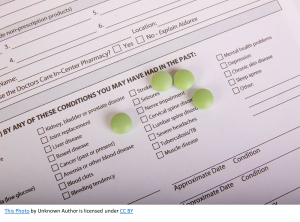1.7. Completing Forms and Writing Progress Notes
Learning Objectives
By the end of this lesson, students will be able to:
- Explain why accurate documentation is important in healthcare.
- Identify key patient information, including chief complaints and symptoms.
- Complete patient history forms and progress notes using clear and concise language.
- Write a progress note using the SOAP format (Subjective, Objective, Assessment, Plan).
Part 1: Brainstorming
- What information does a doctor’s office collect from a new patient?
- patient’s name
-
Part 2: Case Study
Read the case study and answer the questions below.
Case Study: Sonia Lopez visit to a doctor’s Office
Sonia Lopez, 42, is visiting her primary care physician with concerns about persistent fatigue and dizziness. She mentions that she also experiences occasional headaches and shortness of breath. She has a history of high blood pressure but has not been regularly taking her medication due to financial constraints.
- What is Sonia’s main complaint?
- What are potential Sonia’s Symptoms?
- What potential follow up questions can a CMA ask?
- Example: How long have you been experiencing these symptoms?
Part 3: Completing patient history
Vocabulary
Study the medical conditions/symptoms.
Completing patient history

You instructor will provide you with sample patient history forms and will explain the structure and format of the form, emphasizing the importance of clarity, accuracy, and brevity.
You will work in pairs or small groups. Each group will receive a patient history role-play scenario (or case study). One student will act as the patient describing their symptoms, while the other will act as the medical assistant documenting the patient’s history. The “patient” describes their symptoms, chief complaint, and relevant medical history. The “medical assistant” will actively listen, ask follow-up questions if needed, and document the patient’s history on a provided template.
You will switch roles.
Students will switch roles and repeat the process with a different scenario or patient case. After the role-play, students will share their documentation with the class.
Did you have any challenges when trying to accurately record information?
Part 4: Progress notes and daily reports
What are progress notes
Progress notes is used to track a patient’s ongoing condition. The key elements in progress notes are: patient status, changes in symptoms, any treatments or procedures performed, and follow-up actions.
Sample progress notes.
Patient 1: Hypertension Follow-Up
Subjective:
- Patient reports occasional headaches and dizziness over the past two weeks. No chest pain or shortness of breath. Reports adherence to prescribed antihypertensive medication but admits to occasional missed doses. Diet includes moderate salt intake, and exercise is inconsistent.
Objective:
- BP: 150/95 mmHg
- HR: 82 bpm
- RR: 16 breaths/min
- Weight: 180 lbs (no significant change)
- No edema, heart sounds normal, clear lung sounds
Assessment:
- Uncontrolled hypertension, likely due to inconsistent medication adherence and dietary factors.
Plan:
- Reinforce medication adherence and lifestyle modifications (low-sodium diet, regular exercise).
- Consider adjusting antihypertensive medication if BP remains elevated.
- Schedule follow-up in 4 weeks for BP re-evaluation.
Part 5: Your turn
Review the case below and organize the information into a SOAP (subjective, objective, assessment, plan) progress note format. Use clear, concise medical documentation while maintaining the SOAP structure. Consider what recommendations the provider might make based on the assessment.
Case Study: Diabetes Management
Case Background:
Mr. James Carter, a 58-year-old male with a 10-year history of Type 2 Diabetes Mellitus (T2DM), comes to the clinic for a routine follow-up. He reports feeling more fatigued than usual over the past month and has noticed mild tingling in his feet, especially at night. He denies vision changes, excessive thirst, or frequent urination. However, he admits that he has been inconsistent with his diet and blood sugar monitoring.
Vital Signs & Lab Results:
Blood Pressure: 138/85 mmHg
Heart Rate: 80 bpm
Fasting Blood Glucose: 180 mg/dL
HbA1c: 8.2% (previously 7.5%)
Monofilament Test: Slightly diminished sensation in both feet
No visible foot ulcers or injuries
Current Medications:
Metformin 1000 mg BID
Atorvastatin 20 mg QD
Lisinopril 10 mg QD
Media Attributions
- Medical history forms © Unkown is licensed under a CC BY (Attribution) license

